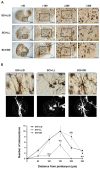Elevated Serum Melatonin under Constant Darkness Enhances Neural Repair in Spinal Cord Injury through Regulation of Circadian Clock Proteins Expression
- PMID: 30678072
- PMCID: PMC6406284
- DOI: 10.3390/jcm8020135
Elevated Serum Melatonin under Constant Darkness Enhances Neural Repair in Spinal Cord Injury through Regulation of Circadian Clock Proteins Expression
Abstract
We investigated the effects of environmental lighting conditions regulating endogenous melatonin production on neural repair, following experimental spinal cord injury (SCI). Rats were divided into three groups randomly: the SCI + L/D (12/12-h light/dark), SCI + LL (24-h constant light), and SCI + DD (24-h constant dark) groups. Controlled light/dark cycle was pre-applied 2 weeks before induction of spinal cord injury. There was a significant increase in motor recovery as well as body weight from postoperative day (POD) 7 under constant darkness. However, spontaneous elevation of endogenous melatonin in cerebrospinal fluid was seen at POD 3 in all of the SCI rats, which was enhanced in SCI + DD group. Augmented melatonin concentration under constant dark condition resulted in facilitation of neuronal differentiation as well as inhibition of primary cell death. In the rostrocaudal region, elevated endogenous melatonin concentration promoted neural remodeling in acute phase including oligodendrogenesis, excitatory synaptic formation, and axonal outgrowth. The changes were mediated via NAS-TrkB-AKT/ERK signal transduction co-regulated by the circadian clock mechanism, leading to rapid motor recovery. In contrast, exposure to constant light exacerbated the inflammatory responses and neuroglial loss. These results suggest that light/dark control in the acute phase might be a considerable environmental factor for a favorable prognosis after SCI.
Keywords: circadian clock; endogenous melatonin; environmental lighting condition; neural remodeling; spinal cord injury.
Conflict of interest statement
The authors declare no conflict of interest.
Figures









Similar articles
-
Beneficial effects of endogenous and exogenous melatonin on neural reconstruction and functional recovery in an animal model of spinal cord injury.J Pineal Res. 2012 Jan;52(1):107-19. doi: 10.1111/j.1600-079X.2011.00925.x. Epub 2011 Aug 19. J Pineal Res. 2012. PMID: 21854445
-
Effects of constant darkness and constant light on circadian organization and reproductive responses in the ram.J Biol Rhythms. 1988 Winter;3(4):365-84. doi: 10.1177/074873048800300406. J Biol Rhythms. 1988. PMID: 2979646
-
Revealing a circadian clock in captive arctic-breeding songbirds, lapland longspurs (Calcarius lapponicus), under constant illumination.J Biol Rhythms. 2014 Dec;29(6):456-69. doi: 10.1177/0748730414552323. Epub 2014 Oct 17. J Biol Rhythms. 2014. PMID: 25326246
-
Intestinal microbiota and melatonin in the treatment of secondary injury and complications after spinal cord injury.Front Neurosci. 2022 Nov 9;16:981772. doi: 10.3389/fnins.2022.981772. eCollection 2022. Front Neurosci. 2022. PMID: 36440294 Free PMC article. Review.
-
New Prophylactic and Therapeutic Strategies for Spinal Cord Injury.J Lifestyle Med. 2013 Mar;3(1):34-40. Epub 2013 Mar 31. J Lifestyle Med. 2013. PMID: 26064835 Free PMC article. Review.
Cited by
-
Oxidative Stress in Neurodegenerative Diseases: From Preclinical Studies to Clinical Applications.J Clin Med. 2020 Apr 24;9(4):1223. doi: 10.3390/jcm9041223. J Clin Med. 2020. PMID: 32344515 Free PMC article.
-
Inhibiting nighttime melatonin and boosting cortisol increase patrolling monocytes, phagocytosis, and myelination in a murine model of multiple sclerosis.Exp Mol Med. 2023 Jan;55(1):215-227. doi: 10.1038/s12276-023-00925-1. Epub 2023 Jan 13. Exp Mol Med. 2023. PMID: 36635431 Free PMC article.
-
The Circadian Clock Gene Bmal1 Regulates Microglial Pyroptosis After Spinal Cord Injury via NF-κB/MMP9.CNS Neurosci Ther. 2024 Dec;30(12):e70130. doi: 10.1111/cns.70130. CNS Neurosci Ther. 2024. PMID: 39648661 Free PMC article.
-
Role of circadian rhythms in pathogenesis of acute CNS injuries: Insights from experimental studies.Exp Neurol. 2022 Jul;353:114080. doi: 10.1016/j.expneurol.2022.114080. Epub 2022 Apr 9. Exp Neurol. 2022. PMID: 35405120 Free PMC article. Review.
-
Olfactory Ensheathing Cell Ameliorate Neuroinflammation Following Spinal Cord Injury Through Upregulating REV-ERBα in Microglia.Cell Transplant. 2024 Jan-Dec;33:9636897241261234. doi: 10.1177/09636897241261234. Cell Transplant. 2024. PMID: 39068549 Free PMC article.
References
-
- Oyinbo C.A. Secondary injury mechanisms in traumatic spinal cord injury: A nugget of this multiply cascade. Acta Neurobiol. Exp. 2011;71:281–299. - PubMed
-
- Abematsu M., Tsujumura K., Yamano M., Saito M., Kohno K., Kohyama J., Namihira M., Komiya S., Nakashima K. Neurons derived from transplanted neural stem cells restore disrupted neuronal circuitry in a mouse model of spinal cord injury. J. Clin. Investig. 2010;120:3255–3266. doi: 10.1172/JCI42957. - DOI - PMC - PubMed
-
- Coutts M., Keirstead H.S. Stem cells for the treatment of spinal cord injury. Exp. Neurol. 2008;209:368–377. - PubMed
Grants and funding
LinkOut - more resources
Full Text Sources
Molecular Biology Databases
Research Materials
Miscellaneous

